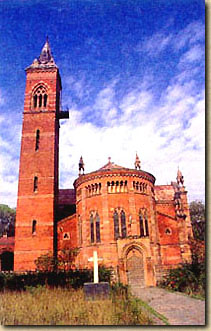|
|

Kanpur
Nestled on the banks of the eternal Ganga, Kanpur
stands as one of North India’s major industrial centres with its own
historical, religious and commercial importance. Believed to be founded by king
Hindu Singh of the erstwhile state of Sachendi, Kanpur was originally known as `Kanhpur’.
Upto the 1st half of the 18th century Kanpur continued to survive as an insignificant village. Its fate,
however, took a new turn soon after. In May 1765, Shuja-ud-daula, the Nawab
Wazir of Awadh, was defeated by the British near Jajmau. It was probably at this
time that strategic importance of the site of Kanpur was realized by the
British. European businessmen had by this time gradually started establishing
themselves in Kanpur. In order to ensure protection to their lives and property
the `Awadh local forces’ were shifted here in 1778. Kanpur passed into British
hands under the treaty of 1801 with Nawab Saadat Ali Khan of Awadh. This forms a
turning point in the history of Kanpur. Soon Kanpur became one of the most
important military station of British India. It was declared a district on 24th
March 1803.
Kanpur was soon to become the epicentre of the
outbreak of 1857, as some of the leading luminaries of the War of Independence
hailed from her, namely – Nana Sahib, Tantiya Tope, Azimoolah Khan and
Brigadier Jwala Prasad. The three strategic events of the 1857 war at Kanpur
were the fight at `wheeler’s entrenchment’, the `massacre at Sati Chaura
Ghat’ and the `Bibighar massacre’. Nana Sahib had declared independence on
the 7th of June 1857 at Kanpur. The British under Commander Hugh
Wheeler retreated into a shallow earth entrenchment in the cantonment area,
later known in history as `wheeler’s entrenchment’. The English garrison
surrendered in the last week of June 1857 on terms of safe passage to Allahabad.
But when on the morning of 27th June, the soldiers along with the
women and children were about to embark into the boats at Sati Chaura Ghat,
fighting broke out and most of the men were killed. The survivors, women and
children were rescued who were imprisoned into the Savada Kothi and later
shifted to Bibighar in the `cantonment magistrates’ compound. But when it
became clear the relieving forces under General Havelock were nearing the city
and defeat was inevitable, the captives-all women and children, were massacred
and their dismembered bodies buried in the well of the compound on 15th July 1857. The Bibighar was dismantled by the British and reoccupation of Kanpur
and a `memorial railing and a cross’ raised at the site of the well. The well
is now bricked over. Only remains of a circular ridge survive, which can be
still seen at the Nana Rao Park. The Kanpur Memorial Church – `The all soul
cathedral’ was raised in honor of the fallen at the north-east corner of
Wheeler’s entrenchment in 1862 by the British. The marble gothic screen with
famous `mournful seraph’ was transferred to the churchyard of All Souls church
after independence in 1947, and in its place a bust of Tantiya Tope installed as
Nana Rao Park.
After 1857, the development of Kanpur was even
more phenomenal. Government Harness and Saddler Factory was started for
supplying leather material for army in 1860, followed by Cooper Allen & Co.
in 1880. The first cotton textile mill, the Elgin Mills were started in 1862 and
Moiré Mills in 1882.
Places Of Interest
Jajmau, Shri
Radhakrishna Temple (J.K. Temple), Jain
Glass Temple, Allen Forest Zoo, Kamla Retreat, Phool Bagh, Memorial
Church, Sati Chaura
Ghat, Military
Cemetery.
Top
|
|



